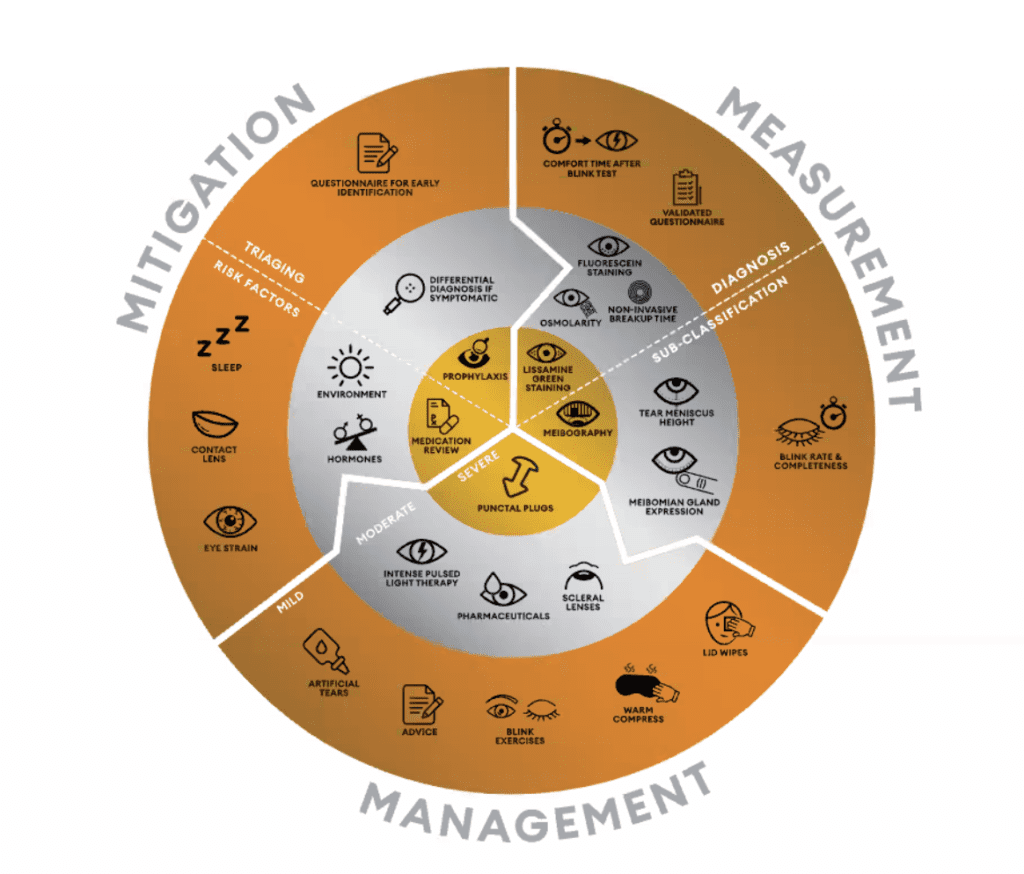On-Demand Educational Videos Now Available Focused on Dry Eye Disease Mitigation, Measurement, and ManagementThe World Council of Optometry (WCO) and Alcon officially launched a new and exciting practical tool to help with the diagnosis and treatment of dry eye disease concluding an initial series of complimentary global dry eye disease education initiative online events. Videos are now available on demand at dryeye.worldcouncilofoptometry.info. The WCO Alcon Dry Eye Wheel, developed by world-renowned educators Professors Jennifer Craig, Lyndon Jones, and James Wolffsohn, is an at-a-glance, interactive tool designed to easily reference the three pillars of mitigation, measurement, and management, and to be accessible for broadest possible use.
World Council of Optometry President-Elect Dr. Sandra S. Block, O.D., M.Ed., MPH, FAAO, FCOVD said, “We are deeply grateful to Professors Craig, Jones and Wolffsohn for their amazing insight on the diagnosis and treatment of dry eye disease during this initial series of webinars. The WCO Alcon Dry Eye Wheel will allow clinicians to integrate mitigation, measurement and management of dry eye disease into practice immediately. I would also like to thank Alcon for the opportunity to address this significant ocular problem together.”
Alcon Global and US Head of Professional Education and Development Carla Mack, OD, MBA, FAAO, FBCLA said, “The WCO Alcon Dry Eye Wheel is a fantastic tool that aims to deliver a great deal of knowledge and an easy-to-apply approach in eye care practices worldwide. Alcon is proud to partner with the World Council of Optometry and our expert faculty as we work to raise awareness of dry eye and support optometrists in helping those who suffer.”
From the University of Auckland (New Zealand), Head of the Ocular Surface Laboratory within the Department of Ophthalmology Jennifer Craig, Ph.D., FCOptom, FAAO, FBCLA, FCLS explained, “The tables within the wheel represent different complexities within what we do. The bronze outer ring shows the simplest, most common things to do to mitigate dry eye disease that are easy, don’t require additional equipment and can help the majority of affected individuals. The silver ring represents slightly more complex versions of the disease that we may be managing and describes basic tools and skills we can use to help at this level, and the gold bullseye reflects the smaller, more complex group of patients that may be in need of more advanced techniques for dry eye disease management.”
Lyndon Jones, DSc, FCOptom, FAAO, Director of the Centre for Ocular Research & Education (CORE) in the School of Optometry and Vision Science at the University of Waterloo (Canada) said, “Once you’ve performed one or more management strategies, the level of dry eye disease hopefully changes and it’s important at that point to reevaluate where the patient now lies on the spectrum, so that the treatment and mitigation strategies can be adjusted accordingly. The concept of using the wheel from the outer to inner layer, keeping things simple wherever possible, and then continually following it around is a great way of thinking about how to manage patients with dry eye disease.”
Aston University (UK) School of Optometry and Audiology Head James Wolffsohn, BSc, MBA, Ph.D., FCOptom, FAAO said, “As a duty of care, we need to manage our patients’ dry eye disease at whatever level we’re able to, keeping in mind that only a small number of patients will need the highest level of practice. Building networks to be able to refer them if they need more specialized care is also important. A standardized diagnosis based on both signs and symptoms is critical, and can easily be made by all eye care practitioners.”
The dry eye disease education initiative website also features other evidence-based, practical tools that eye care professionals can use regardless of their geographic location or available resources.
WCO and Alcon partnered to develop the dry eye disease education initiative to raise optometrists’ understanding of dry eye and deliver resources on practical management. Dry eye disease can be a chronic, painful condition. About 1.4 billion people are affected by dry eye symptoms worldwide,[1] with reports of increased occurrence aligning with notable factors such as increasing use of technology, environmental triggers, and an aging population.[2] The education initiative brings together world-renowned experts to share the latest dry eye disease data and science with the entire optometric community.
About the World Council of OptometryThe World Council of Optometry (WCO) is an international membership-based non-profit organization for individual optometrists, industry professionals and optometric organizations that envisions a world where optometry makes high quality eye health and vision care accessible to all people. Its mission is to facilitate the development of optometry around the world and support optometrists in promoting eye health and vision care as a human right through advocacy, education, policy development and humanitarian outreach. To learn more, please visit www.worldcouncilofoptometry.info or follow us on LinkedIn, Facebook, Twitter and Instagram.
About AlconAlcon helps people see brilliantly. As the global leader in eye care with a heritage spanning over 75 years, we offer the broadest portfolio of products to enhance sight and improve people’s lives. Alcon’s Surgical and Vision Care products touch the lives of more than 260 million people in over 140 countries each year living with conditions like cataract, glaucoma, retinal disease, and refractive error. Our more than 24,000 associates are enhancing the quality of life through innovative products, partnerships with Eye Care Professionals and programs that advance access to quality eye care. Learn more at www.alcon.com.
Media ContactsCharla Kucko, McDougall Communications for the World Council of Optometrycharla@mcdougallpr.com or +1-585-434-2146
Kevin Nicoletti, Director, Global Franchise Communications, Alconkevin.nicoletti@alcon.com or +1-817-551-8549
